
Space odyssey: As employees head back to offices, companies rethink workplace setups
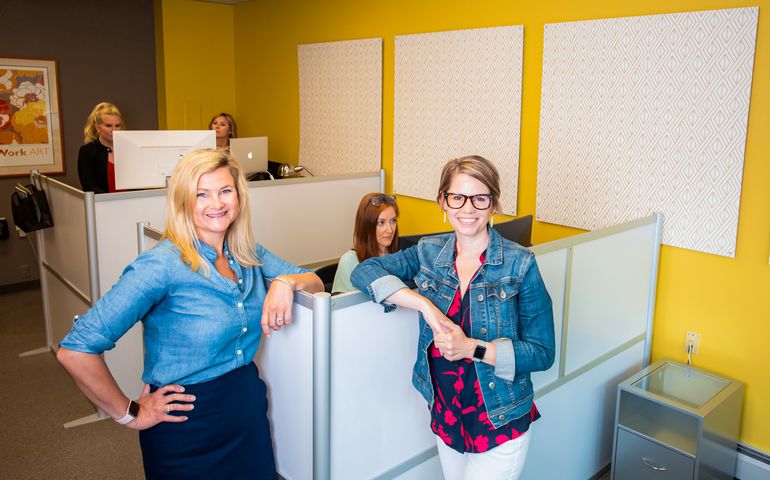 Photo / Tim Greenway
Warp+Weft co-owners Jennie Malloy, left, and Aimee Goodwin at the branding agency’s Auburn office. The firm reconfigured its 1,000-square-foot downtown space.
Photo / Tim Greenway
Warp+Weft co-owners Jennie Malloy, left, and Aimee Goodwin at the branding agency’s Auburn office. The firm reconfigured its 1,000-square-foot downtown space.
As offices open back up after pandemic closures, hybrid working appears here to stay and employers from Main Street to Wall Street are rethinking their space needs.
In Maine, Auburn-based branding firm Warp+Weft had mulled a move from a 1,000-square-foot office downtown that felt cramped before the pandemic. Now, with a staff of six, the company decided to stay put and redesign its existing space with collaboration and brainstorming in mind. It did that by getting rid of half the individual workstations and replacing them with couches and chairs, while leaving four unassigned desks for anyone to use when they come in.
“We are still a work-from-anywhere company,” says Jennie Malloy, who owns the company with Aimee Goodwin and heads up strategy. “Well before the pandemic, Aimee and I decided we didn’t need a huge space and we didn’t need to quadruple our rent or buy a building when we know we can be successful working from anywhere, but we still want someplace where we can all gather … It makes so much more sense.”
Nationwide, companies that have the luxury of working remotely are in a similar position and finding that there’s not one size fits all. Many are opting for a blended or hybrid model with a physical space for people to meet while allowing them to keep working from home if they can and want to.
Among bigger corporate entities, Citigroup and Apple have opted for flexible work policies. Twitter, Facebook and outdoor clothing retailer REI are making work from home the new norm. While some Wall Street heavyweights like Goldman Sachs and JPMorgan Chase & Co. are reportedly insisting on a full return to their offices, the move to hybrid work is gaining momentum.
That’s backed up in various reports including a global survey for Cisco Webex published in October. It found that 99% of companies plan sweeping workplace changes in light of COVID-19, and that 77% of large organizations will increase work flexibility while 53% will shrink office sizes.
Similarly, Microsoft in its latest report on workplace trends says the move to hybrid work puts the world “on the brink of a disruption as great as last year’s sudden shift to remote work.”
Less space, more choices
In Maine, changing perceptions of the workplace are playing out in office real estate and design though still with many unknowns.
“Now that office users have a choice as to whether they’ll be fully in-person, hybrid or fully remote, I think we’ll spend the next six to 12 months experimenting with what works best,” says Justin Lamontagne, a partner and designated broker with NAI The Dunham Group. “Thereafter, long-term commitment to office space, either smaller or larger, will return.”
Lisa Whited, a Portland-based advisor on employee engagement and workplace strategy, expects the shift to smaller spaces that predates the pandemic to gain momentum in coming months.
Based on her calculations, most companies could choose to do with 50% to 80% less office space than pre-COVID if they rethink conventional office layout or, if willing to take the plunge, then go entirely remote.
In talking to an organization’s leaders and employees on finding the right formula, Whited starts with the bigger picture.

“I always back up and say, ‘First I’m going to talk about purpose and vision, and then we’ll get to space,’” she explains. “If you let the space drive the decision, it’s a false conversation because it is easier to do what we’ve always done instead of imagining new possibilities.”
On a larger scale, Red Thread is a Boston-based firm that advises companies throughout New England on innovative workplace environments integrating furniture, technology and architecture.
In Maine, where it employs 10 people and has an office furniture showroom in Portland plus a warehouse in Gorham, it’s also figuring out its own workplace setup, according to Stephanie Brock, vice president and general manager of Red Thread Maine. Its clients include Tilson, the Roux Institute, Martin’s Point Healthcare, Avangrid and Pratt & Whitney.
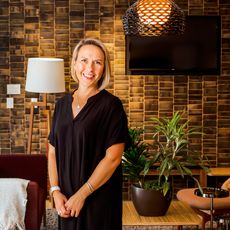
“We’re facing the same challenges as to how do we repurpose a space to include the technology we need and get people back into the space and not have to do it so expensively,” Brock says. “We’re learning from our customers and our customers are learning from us.”
Engineering a ‘fresh look’
Like many companies during the pandemic, engineering firm Sewall encouraged employees who could work remotely to do so.
The company, owned by Yarmouth-based Treadwell Franklin Infrastructure Capital, is based in Old Town, where it has employed up to 200 people in its headquarters going back more than 140 years. Today Sewall employs around 50, half of whom are based out of its main office.
After determining that it would need a lot less space for people in the future who would keep working remotely and use the office mainly for meetings, Sewall decided to steer clear of using plexiglass partitions and barriers between individual workstations, opting to downsize from 20,000 square feet.
Sewall sold its headquarters building to Bangor’s Dresser Properties for an undisclosed amount, and will lease a much smaller space in downtown Bangor it will build out with a “fresh new look for our associates,” says Chuck Nadeau, Sewall’s president and CFO. A move to the 7,000-square-foot facility is planned for September.
“In some ways we have designed it with the thought that we’re not going to have 25 or 30 people in every day, and that the workstations will be slightly smaller than they were used to in the prior facility,” Nadeau says. On the other hand, “we’ve built in more open, collaborative space where people can gather around larger tables and work on projects together.”
While the build-out is still a work in progress, he says the aim was to get back to something that “feels more normal to people prior to the pandemic, and where people feel OK working in collaborative open spaces with other people.”
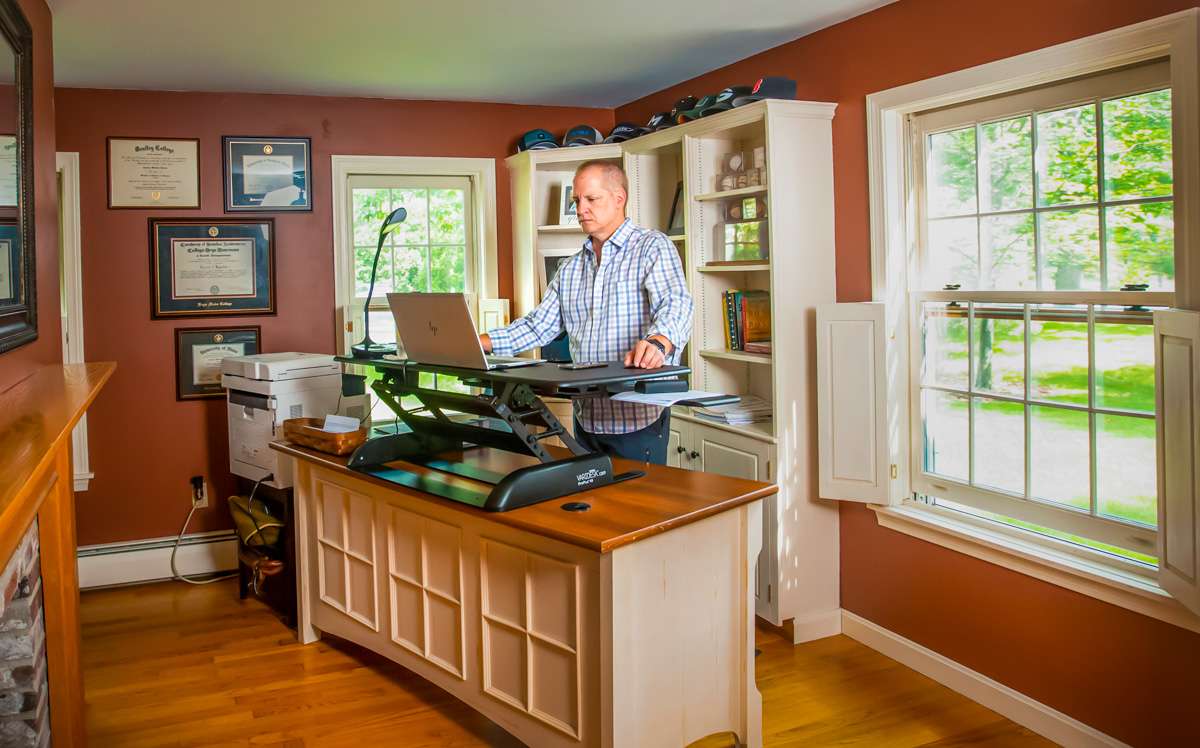
Nadeau says the opportunity to sell the Old Town building came at the right time for all concerned.
“For us it was an opportunity to do what we needed to do — get smaller, get more intimate, get newer and fresher and energize the environment,” he says. “The timing aligned well.”
He also says while the new space will allow for additions to the workforce, it remains to be seen how many people will regularly be in the office.
“Even as we move into the new space and provide some direction to people around our expectations of time in the office, we’re still in learning mode,” he says. “For sure we’re growing, but sometimes our growth comes from hiring people remotely.” As an example, he pointed to a recently hired female engineer who is working remotely from Columbus, Ohio.
“We’ve built in some space for growth and expansion, but not an excessive amount,” he says. “What we’ve learned over the past year has educated all of us that we can all work effectively in different ways from distances we didn’t realize we could before.”
Wait and see at WEX
In Portland, payments provider WEX Inc. — which employs 1,232 people in Maine out of 5,098 worldwide — is treading slowly on a return to the office.
Both of its Portland buildings are currently open to employees, vendors and visitors, according to Claire Conan, the HR leader of the company’s back-to-work initiative.
Under an agreement that pre-dates the pandemic, WEX is subletting space in its smaller building on Fore Street to Northeastern University’s Roux Institute and an art gallery that’s coming soon.
While WEX does not mandate vaccinations for employees, it requires anyone who enters its buildings to complete a health screening survey — staff can do so via a phone app — nor is it requiring employees to return to the office until next year.
On the real estate front, WEX plans to keep the two buildings open for employees and has consolidated away from some of its older facilities while holding off on a $50 million office building project in Scarborough, as it said in October.
However, “we remain excited and steadfast to provide employees the office structure that will best fit the future,” says Safet Cobaj, WEX’s vice president for global real estate.
Remote or hybrid work also extends to nonprofits. At the Maine Association of Nonprofits, half the staff is currently working in its office on Congress Street in Portland while the other half is remote as the group looks at hybrid event formats and virtual offerings to reach more audiences, according to Kelly McCormack, the organization’s development and marketing manager.
Similarly in Beals, the Downeast Institute — which operates the state’s first and only public shellfish hatchery—is not requiring people who have been working remotely during the pandemic to return to the office.
“They’re doing it by choice,” says Executive Director Dianne Tilton, who leads a staff of 14. “As I look to retirement in the next five to seven years, and others do as well, it opens up our potential candidate pool because administrative jobs can very easily be done remotely.”
Back to work at Bangor Savings Bank
Meanwhile in Bangor, 480 Bangor Savings Bank employees have been back full-time at the bank’s sprawling two-building campus overlooking the Penobscot River, since June 1. All but 40 had been working remotely during the pandemic.
The return followed a staggered trial run with half of the workforce for the first two weeks of May, then the other half the following two weeks, according to Wendy Durrah, senior vice president and chief of staff.
To ensure safe indoor air, Bangor Savings has embarked on upgrades at its Bangor facility, which takes up around 150,000 square feet.
They include installing state-of-the-art filters that go beyond typical commercial setups; increasing the percentage of fresh air as opposed to recirculated air and bringing in more outdoor air; ventilating buildings around the clock; and equipping elevators with air ionization systems. Bangor Savings spent under $50,000 on all the retrofits, a spokeswoman says.
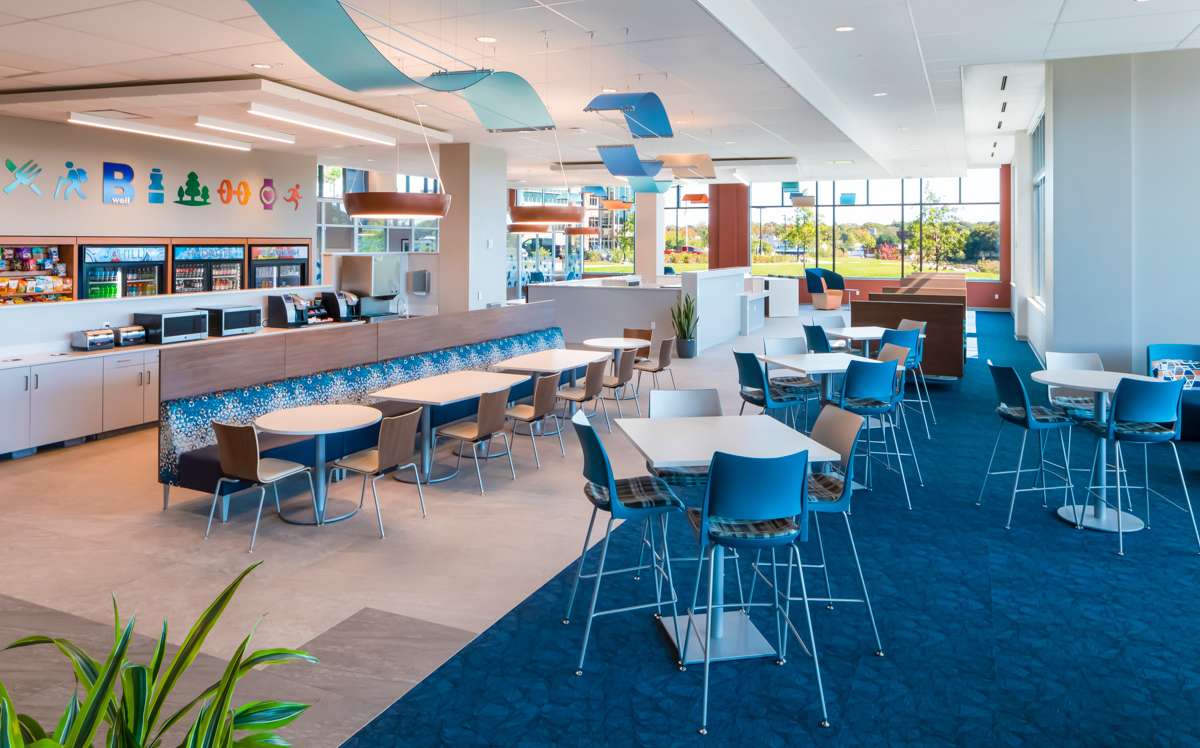
Having ample open space already proved to be fortuitous during the pandemic, and the bank is working with architects on optimal setups for cubicles and workstations. As the bank looks to fill job openings in Bangor and elsewhere, it’s doing so with future space limitations in mind and could easily go remote again if needed, according to Durrah.
While it was strange at first to be back in the office, people adjusted quickly, she says, noting: “You forget the energy you get from each other. It has been nothing short of joyful to have everybody back together.”
Similarly in Auburn, Warp+Weft’s Malloy says she relishes working from home, kept company by a 90-pound chocolate-brown poodle named Charlie, or from her office that’s within easy walking distance. She also looks forward to new “in-person Thursdays” every other week, when “we can brainstorm and connect and be creative together as opposed to being creative through a screen.”









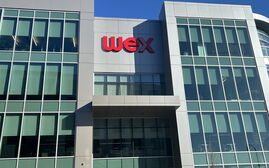





0 Comments